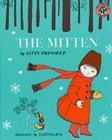You make me excited for Christmas (for which I am otherwise woefully unprepared). I adore Inga Moore.
 With winter coming, we've been doing a lot of reading of another book about large animals and small animals trying to live together in a space that doesn't quite work for them: The Mitten, retold by Alvin Tresselt. It's a traditional Ukranian folktale, and the illustrations by Yaroslava in this version give it a very Easten European feel.
With winter coming, we've been doing a lot of reading of another book about large animals and small animals trying to live together in a space that doesn't quite work for them: The Mitten, retold by Alvin Tresselt. It's a traditional Ukranian folktale, and the illustrations by Yaroslava in this version give it a very Easten European feel. A little boy out gathering firewood for his grandmother on the coldest day of winter drops his mitten in the snow. The narrator opines: "Now, how a boy could do this on the coldest day of winter I'll never know, but that's the way my grandfather tells the story."
The boy goes off, and a mouse decides to crawl into the mitten to keep warm. She is soon joined by a parade of animals who increase in size and absurdity: a frog, an owl, a rabbit, a fox, a wolf, a boar. The mitten gets more and more snug; seams start to strain. Then a bear comes along.
"No room! No room!" cried the animals even before the bear had a chance to speak.
"Nonsense!" said the bear. "There's always room for one more."
And without so much as a please or thank you, he began crawling into the mitten.
He put his paw in first, and the mitten creaked and groaned.
He put his other paw in, and one of the seams popped.
Then he took a deep breath and pushed himself in.
So you think it's going to be the bear who makes the mitten explode -- but it isn't! The last straw comes in the form of a tiny cricket, who shows up just after the bear in a very pleasing reversal of expectations. NOW the mitten explodes, and all the animals get tossed out across a double-page spread into the snow.
The boy realizes he's lost his mitten, and comes back to look for it, but all he can find are the ripped-apart pieces. The book ends, "And my grandfather says he never did know what really happened to his mitten." The idea that this reveals that the story is made up is lost on my kids -- kind of a complex thing to explain -- but it has led to some interesting conversations.
Eleanor and Isabel love the repetition in the story, the way the mitten-house gets more and more ridiculous. There's suspense and humor, and Yaroslava draws all the animals in traditional Ukrainian clothing, which is very funny. I also appreciate that the animals are of mixed gender, pretty much half male and half female. Half of the pictures are black line drawings on turquoise-blue pages; the other half are on white pages with the color inked in in a pleasingly solid way. It's high-contrast, and very appealing to the eye. It's also, after you close the book, a fun game to play with a blanket and couch cushions.
Love, Annie

No comments:
Post a Comment